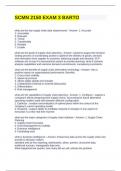SCMN 2150 EXAM 3 BARTO
what are the key supply chain data requirements - Answer- 1. Accurate
2. Accessible
3. Relevant
4. Timely
5. Transferable
6. Reliable
7. Usable
what are the goals of supply chain planning - Answer- solutions support the forward-
looking process of coordinating assets to optimize the delivery of goods, services
and information from supplier to customer, balancing supply and demand. SCP
software sits on top of a transactional system to provide planning, what-if scenario
analysis capabilities and real-time demand commitments, considering constraints.
what are the benefits of supply chain information technology - Answer- Has a
positive impact on organizational performance. Benefits:
1. Cross chain visibility
2. Speed up process
3. Allows agility (adapt and change)
4. Collaboration (internal or external data pools)
5. Differentiation
6. Risk management
what are the capabilities of supply chain planning - Answer- 1. Configure - support a
company's efforts designing their supply chains, accounting for future alternative
operating models/ trade-offs between different configuration.
2. Optimize - creation and evaluation of optimal plans within the context of the
company's current operating model.
3. Respond - support ability to profitably respond to changes in any aspect of
execution in a near-real-time manner.
what are the major categories of supply chain software - Answer- 1. Supply Chain
Planning
2. Supply Chain Execution
3. Event Management & Visibility
4. Business Intelligence
5. Facilitating tools
what is business intelligence - Answer- Extract key data across the supply chain and
provide to decision makers
standard and ad hoc reporting, dashboards, alerts, queries. structured data,
traditional sources, manageable data sets.
What happened last quarter, how many did we sell, wheres the problem
, what is predictive analytics - Answer- optimization, predictive modeling, forecasting,
statistical analysis. structured/unstructured data, internal/external data, massive data
sets
what if, whats the optimal scenario for our business, what will happen next, what if
these trends continue, why is this happening
How is global SCM different from domestic SCM? - Answer- Global SCM focuses on
planning, implementing, and controlling the cross-border flows of materials, money
and information between companies in different countries
Global networks are more complicated
-multiple participants
-new types of orgs & role players
-Global logistics operations are more challenging
-greater distance & +3 distinct moves
-extensive product handling
-shipment visibility issues
what is the purpose of global sourcing - Answer- capacity access, risk reduction,
supplier innovation
What costs and risks must be considered for global sourcing? - Answer- longer lead
times, high transportation cost, higher logistics costs via inventory, increased chance
for in transit damage and theft, reduced supply chain visibility, and lower intellectual
property protection
what are the drivers of global sourcing - Answer- social changes, technology, the
environment, economics, and politics
what are the advantages of global sourcing - Answer- reducing costs, growth in
developing countries, improve quality, respond quickly to a changing market
what are the disadvantages of global sourcing - Answer- increase unemployment,
child labor exploitation ($200 million), unfair labor practices, negative environment
impact
what are your global production alternatives in managing risk, investment, and
control - Answer- avoidance, retention, sharing, transferring, and loss prevention and
reduction.
how do you calculate an exchange rate - Answer- starting amount/ending amount =
exchange rate
what are incoterms - Answer- -International Commercial Terms. Created by
International Chamber of Commerce
-Group 1 Incoterms: apply to any mode of transport
-Group 2 Incoterms: apply to water transportation only
-International rules that are accepted by governments, legal authorities, and
practitioners worldwide for the interpretation of the most commonly used terms in
international trade.




